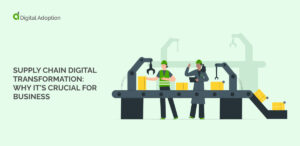The silver bullet solution. It’s what we all want.
And since digital adoption is “the single most important factor for a digital tool to become a digital asset,” we all want a silver bullet digital adoption model.
But does one even exist? Researchers have been disagreeing over this since the technology acceptance model was created in 1989.
What is the technology acceptance model?
The technology acceptance model (TAM) is a theory that models how users come to accept and start using a new technology.
The two main factors that influence this process are perceived usefulness (PU) and perceived ease-of-use (PEOU).
PU was defined by Fred Davis in 1989 as “the degree to which a person believes that using a particular system would enhance his or her job performance”.
Davis defined PEOU as “the degree to which a person believes that using a particular system would be free from effort”.

Criticism of TAM
TAM is frequently used as a model for technology adoption. However, it has also been widely criticized. The main criticisms are that it’s trivial, has limited predictive power, and no practical value.
Perceived ease of use is also unlikely to be an accurate determinant of a user’s intention to use technology. This has been shown to be the case in studies of telemedicine, mobile commerce, and online banking.
So is there anything we can learn from TAM as a digital adoption model? Perhaps, when it comes to digital adoption for customers.
TAM’s usefulness as a digital adoption model
When we talk about digital adoption in business, there are usually two groups of potential users: employees and customers.
Employees have to adopt new digital tools and technologies all the time as organizations transform and adapt to the digital world. Examples are digital communication and collaboration platforms, CRM, invoicing, and HR software.
Usually, in an enterprise scenario, when a new technology is introduced, employees don’t get a choice as to whether they use it or not. The new system replaces the old and employees must adopt it regardless of whether they perceive it as useful or easy to use.
In a customer digital adoption scenario, however, PU and PEOU play a much bigger role.
“Because new technologies such as personal computers are complex and an element of uncertainty exists in the minds of decision makers with respect to the successful adoption of them, people form attitudes and intentions toward trying to learn to use the new technology prior to initiating efforts directed at using.” (Davis, Bagozzi & Warshaw)
As a customer of yours, my user experience (UX) of your digital product is critical to my decision to do business with you. And that includes my perception of the user experience.
If I don’t think your digital product is going to be easy to use or useful to me, I’m not going to buy it. I’ll look at competitor products, which I perceive to be easier to use or more useful based on my goals.
Employees, on the other hand, don’t have the same kind of purchasing power.
A digital adoption model for employees
So what sort of digital adoption model works for employees adapting to new technology? This is where organizational change management theories come in.
“[Digital adoption] is a vital concern for any organization in the process of installing or implementing a new service or tool.” Philip Kushmaro, CIO.com
When an enterprise is implementing new technology as part of its ongoing digital transformation, digital tools are often imposed upon its employees. Whether or not they perceive them as easy to use or useful is usually irrelevant.
This is why a successful digital adoption model for employees should focus on overcoming their resistance to change.
Change can be frightening and frustrating for employees. It makes them feel uncomfortable, as they’re being faced with something that’s unfamiliar.
The constant change of the digital world can be exhausting and is a major cause of employee burnout. So resistance is understandable.
However, digital change is inevitable. So the answer to seamless digital adoption lies in a people-focused organizational change model, like Prosci’s ADKAR or Kotter’s 8-step process.
In summary
There is no silver bullet digital adoption model. Depending on whether your users are employees or customers, you may find some value in the technology acceptance model.
Digital adoption is a process of change, so you will find people-focused change management principles helpful.
Whatever you do, consider your users. Its their experience that counts. How can you make their digital experience better and easier?
Use a digital adoption tool to improve the user experience. Because a good user experience will mean better and faster digital adoption.













